What are hip dips?
The inward depression, just below the hip bone, along with your body’s sides, is called hip dips. Some people use the term violin hips for them. Rather than the outer edges of the hips following curves which look like they’re drawn with a protector, they have depressions or indentations. These depressions may be slight, making them barely noticeable, or they could actually be rather prominent. Hip dips are a normal part of a person’s body structure.
What are the reasons for hip dips?
These indentations occur where your skin is attached, or tethered, to the part of your thigh bone which is deeper than the others, called the trochanter. In some people, hip dips are more noticeable. Their prominence depends on three aspects; your hips width, your pelvis shape, and your body fat distribution. Sometimes they are more prominent when you are wearing the clothes of a certain type.
Exercises that Minimize Violin Hips
People often ask the question of how to get rid of violin hips. The answer to this question is quite simple. To reduce the appearance of violin hips you can do some specific exercises. These exercises will help you lose fat and build muscle.
Keep a check at yourself to make sure you are doing the moves correctly. For the exercises which do a single side at a time, start those exercises with your less flexible or weaker side. This way, you do the more difficult side first and then the other side will feel easier to exercise.
Initially, do 1 to sets a day increase gradually. You will likely want to do different exercises on differing days. Try to utilize at least 20 minutes every day while doing such exercises and set a target of doing these exercises 4 to 6 times at least a week.
These body exercises work to strengthen and tone muscles in your
- Abdominals
- Thighs
- Hips
- Buttock
Infographic

1. Side hip openers (fire hydrants)
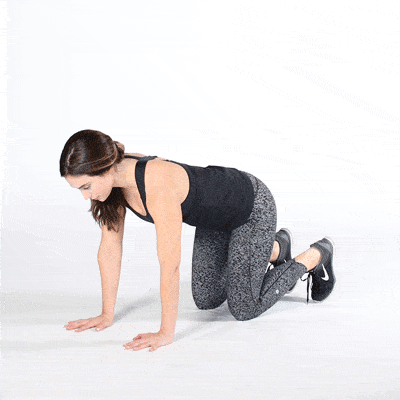
This exercise targets your hips, side buttocks, and thighs. When doing it make sure to distribute your weight evenly between your knees and hands. You can also use dumbbells behind your knees for these movements to increase the difficulty level.
- Adopt cat-cow pose by going down on all fours. Make sure that your hands are placed directly below your shoulders. Also, your knees should be directly below your hips.
- Lift one leg with an inhale so that it makes an angle of 90 degrees with your other leg. Meanwhile, keep your knee bent.
- Slowly, move your leg down to its initial position. Don’t let your knee touch the floor this time before you lift your leg again.
- Practice this movement 15 times. On your last repetition, before lowering your leg pulse it 0 times in its upper position.
- Repeat the same movements on the opposite side.
2. Standing kickback lunges
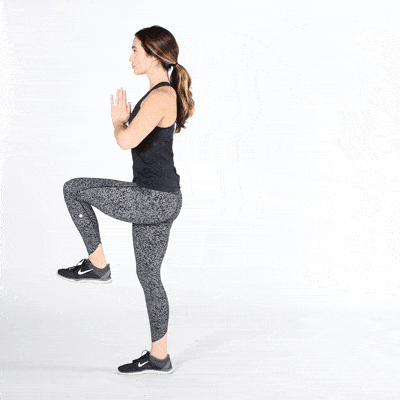
This is a great exercise to develop stability and balance in your body. It works your buttocks and thighs. Make sure that your front foot and leg are engaged. Also, keep your core engaged throughout the exercise.
- Get in a standing position just like prayer pose with your hands placed in front of your chest.
- With an inhale to lift your right knee to chest level.
- With an exhale raise your arms up and alongside your ears while keeping your palms facing one and other and your right leg stepped back.
- Sink down your right knee into a lunge. Maintain the position on your back foot’s ball with your toes in the forward direction.
- With an inhale, raise your right knee back up to chest level. Also, return your hands to the prayer position at the same time.
- Do 12 lunges. When doing the last repetition, pulse your leg up and down while keeping it back.
- Repeat on the other side.
3. Standing side leg lifts
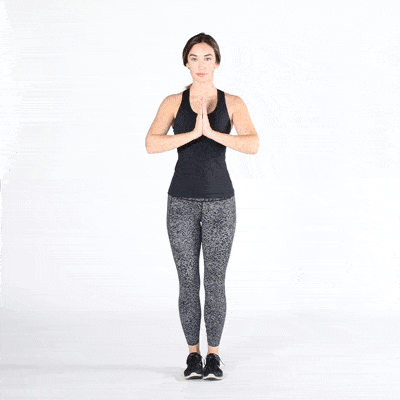
This exercise helps to build up the muscles along the sides of hips and your buttock. You will probably feel your inner thigh stretch. Make sure that you do the movement in a steady and controlled manner. Don’t rush or jerk the movement, and do try to keep the body straight. Don’t lean to either side.
For added difficulty use ankle weights when doing this exercise.
- Stand with your left side close to a wall, chair, or a table. And face forward.
- Use your left hand for support and balance, and root into the left foot. Then lift your other as in right foot off the floor, slightly.
- With an inhale, slowly raise your right leg to one side.
- On an exhale slowly lower your right leg and then cross the opposite leg.
- On both sides practice 12 leg lifts.
4. Squats

Squats are an excellent way to tone your hips, butt, and thighs. Make sure that your back is straight and your toes forward. For extra support engage your abdominal muscles. You can even hold a dumbbell when doing these squats.
- Stand so that your feet are a little wider than your hips.
- With an exhale, slowly lower your body as though you are sitting in a chair.
- With an inhale stand back up.
- Repeat this exercise 12 times.
- On your last repetition, hold onto the lower pose and do 12 up and down pulses.
5. Standing side-to-side squats
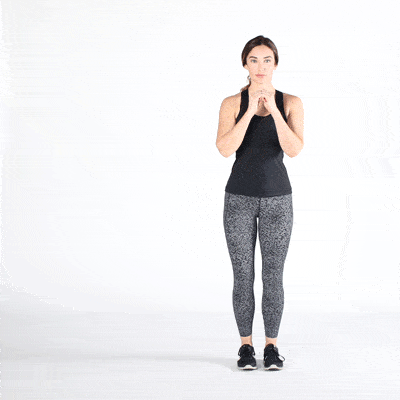
This exercise works the sides of your hips, buttock, and legs. During these squats keep your buttock low. Squat a little lower every time both your feet come together. You can also come up a bit as you move. Do not fully come up. Ankle weights can also be used when doing this exercise to increase the difficulty level.
- Stand with your feet close to each other.
- Lower down into a squat position
- Extend your right foot to your right
- Then move your left foot close to your right foot.
- Next, move your left foot to your left side.
- Then move your right foot close to your left foot.
- On each side do 10 such squats.
6. Side Lunges

This exercise works your whole leg. Side lunges help define your buttock and hips. Make sure that the toes of your both feet are facing forward. To increase you can hold dumbbells while doing this exercise.
- Stand so that your feet are directly below your hips.
- While keeping your right foot rooted, step to the left with your left foot.
- Place your left foot on the ground. Then move your butt down. This way your right leg will remain straight and your other leg will be bent.
- Keep pressing in both feet.
- Stand up straight and bring together both your feet.
- On each side do 12 lunges.
7. Side curtsy lunges

This exercise works the side of your butt and your thighs. Try to keep your body low towards the ground for the whole time. Your front foot toes should be facing forward. Ensure that you are actually stepping out to your side. To increase the difficulty level you can hold the dumbbells while doing these lunges.
- Start with both your feet together.
- Raise your right leg and then move it behind the left leg.
- Then go into a curtsy lunge by dropping your right knee down.
- Move your right foot to get it in front of your other foot.
- Repeat the steps on the opposite side.
- On each side do 15 lunges.
8. Glute bridges
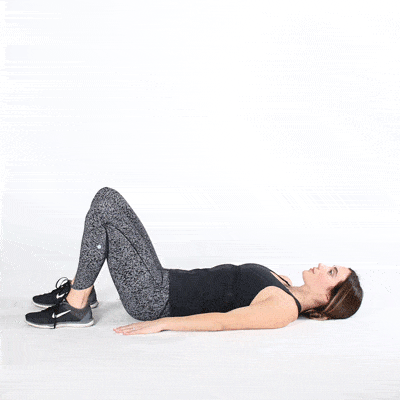
Glute bridges work your thighs and buttock. Engage your abdominal muscles when doing this exercise. This will aid you in supporting your body and working out your stomach muscles.
- Lie down onto the ground on your back with your knees bent and the arms alongside the body.
- Place your feet a little wider than our hip-width.
- On an inhale, slowly lift up your butt and hips.
- On an exhale lower your body back down.
- Repeat it 5 times. On your last repetition, keep the upper pose for 10 seconds at least.
- Then bring your knees together carefully and back apart. Do it 10 times.
9. Leg kickbacks
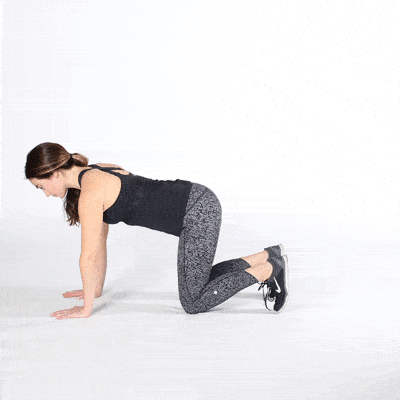
Leg kickbacks help lift your buttock. In order to protect your lower back, keep your core engaged. Do the exercise slowly. To increase the level of difficulty you can also use ankle weights.
- Adopt cat-cow pose by going down on all fours.
- Keep your knees below your hips and your hands below your shoulders.
- Move your right leg straight out. Then, slowly raise your leg as high as it will possibly go.
- Lower your leg and return it to the ground, but don’t let your foot touch the floor.
- Repeat the movement 15 times. On your last repetition, make your leg parallel to the floor by keeping it lifted. Do 15 up and down pulses of your leg.
- Repeat the movement on the opposite side.
10. Lying down side-leg raises

This exercise targets your butt and outer thighs. Make sure that you use your butt and hip muscles to perform the exercise. To increase the level of difficulty, you can also use ankle weights.
- Lie down straight on your right side. Ensure that your body forms a straight line.
- Bend the right elbow and to support your head use your hand. Or just keep your arm on the floor.
- For support place your left hand on the ground.
- Raise your left leg up slowly into the air
- Lower down your leg but don’t let it make contact with your right leg.
- Repeat the movement 20 times. On your last repetition, do 20 pulses while keeping your leg raised at the top.
- Repeat the movement on the opposite side.
Lifestyle changes to get rid of violin hips
Try your best to develop a healthy lifestyle by taking the necessary steps. A good diet, regular workout, and good self-care will make you feel good and confident.
Take the right amount of calories; not very high or too less, and increase your water intake. For added energy take carbohydrates so that you can maximize your workouts. Eat lean protein as it helps in building muscle mass. In your diet include plenty of fibers, calcium, and healthy fat. Avoid sugar, alcohol, and processed junk food. Make smart and healthy food choices, but it is fine to be indulgent once in a while.
Workout your other body parts to keep your fitness routine in a balance. For body transformation, a variety of exercises are needed. Make physical activity a part of your daily routine and stay dedicated to your workout routine. For guidance consult your fitness professional, nutritionist, or doctor.
Bottom line
Remember that your results could be gradual. It may take weeks or even months until you can see a noticeable change in your body. So be positive and act like an optimist. Use positive self-talk to motivate yourself and focus on the things that you love about yourself and your body.
Stick to a wellness plan or routine which helps you feel good. Set both long-term and short-term goals for yourself. Because when you will achieve those goals, you will feel and look a lot better.
FAQs
[su_spoiler title=”Can you actually get rid of hip dips?” open=”yes” style=”fancy”]No, you can’t fully get rid of them. But with exercises, they can become less noticeable. So try to lose extra belly fat and tone your thighs.[/su_spoiler]
[su_spoiler title=”Why do hip dips happen?” open=”yes” style=”fancy”]Hip dips are present where the skin is attached or tethered to the part of the thigh bone which is deeper than the rest. It is known as the Trochanter. The depth of these dips varies from person to person. The reason for this is the distribution and amount of muscle and fat in the structure of your body.[/su_spoiler]
[su_spoiler title=”How do you work out your hips?” open=”yes” style=”fancy”]You can do the following exercises:
- Side hip openers; fire hydrants
- Standing kickback Lunges
- Standing side leg lifts
- Squats
- Standing side-to-side squats
- Side lunges
- Side curtsy lunges
- Glute bridges
- Leg kickbacks
- Lying down side-leg raises
[/su_spoiler]
[su_spoiler title=”What helps hip dips?” open=”yes” style=”fancy”]Squats and lunges are an excellent way to tone your hips, butt, and thighs, in turn, help the hip dips.[/su_spoiler]
[su_spoiler title=”Does everyone have hip dips?” open=”yes” style=”fancy”]No, everyone doesn’t have hip dips. Some people have and some don’t. Sometimes they are subtle and sometimes they are not. Know that violin hips are absolutely normal.[/su_spoiler]
[su_spoiler title=”Will my hips widen?” open=”yes” style=”fancy”]Yes, they will widen with age and certain exercises. To widen the hips through exercise, focus on intense moves which target medius, minimus, and gluteus muscles.[/su_spoiler]
[su_spoiler title=”Do a woman’s hips get wider?” open=”yes” style=”fancy”]Yes, they do get wider with age and exercises. A woman’s hips get wider not only because of fat but also because the pelvic bone in women grows wider.[/su_spoiler]